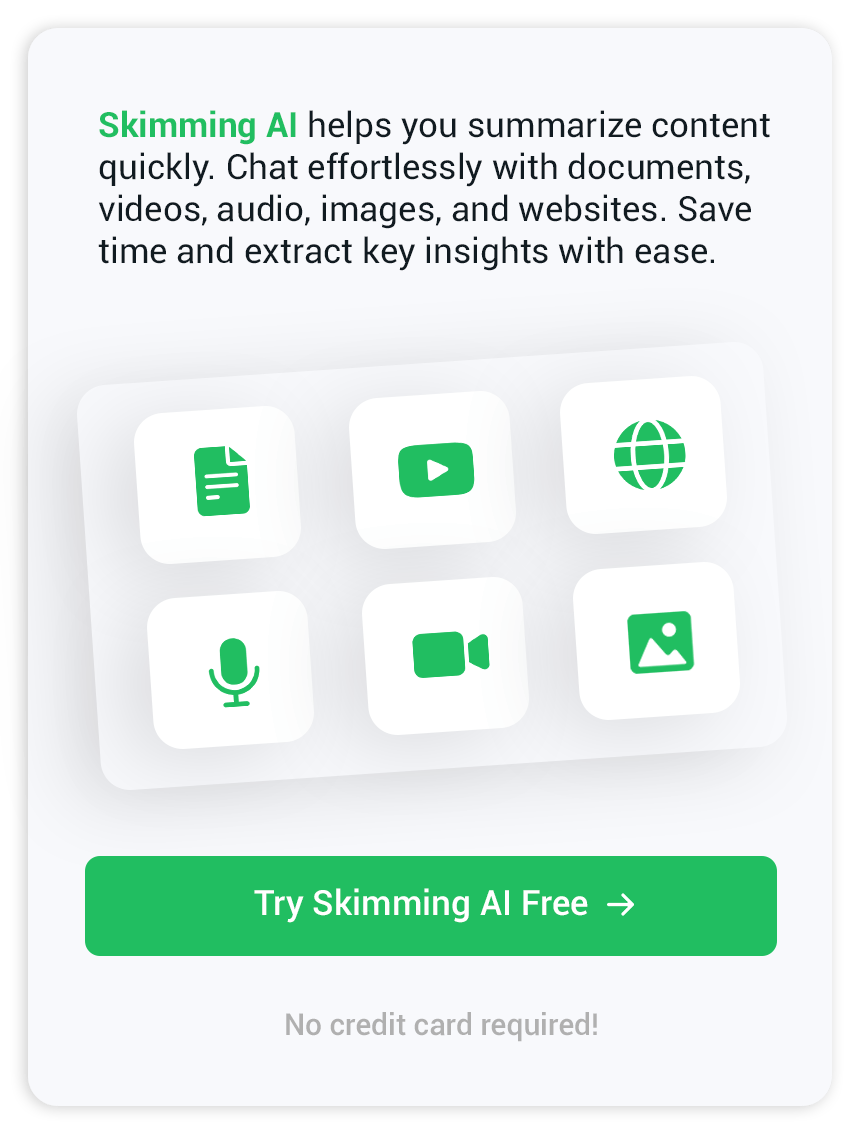AI vs. Human Summarization: Which Is Better For More Productivity
What’s better—AI-generated summaries or the insights only humans can offer? The debate isn’t about choosing sides; it’s about understanding how these two approaches work together. While AI can save time and tackle large-scale data, human summarization brings depth, context, and a nuanced perspective. In this blog, we’ll explore the strengths and limitations of both, show where they intersect, and help you decide when to use each.
The Power of AI Summarization
AI-powered summarization tools, like Skimming AI, process content in seconds. They use Natural Language Processing (NLP) to extract key points from massive amounts of text, videos, or images.
Here’s why AI summarization stands out:
Feature | AI Strength | Human Advantage |
Speed | Processes thousands of words in seconds. | Slower but allows for deeper understanding. |
Consistency | Delivers uniform results across documents. | May vary depending on the summarizer's expertise or fatigue. |
Scalability | Handles massive data sets efficiently. | Limited to human capacity. |
Contextual Insight | Identifies patterns but may miss subtleties or tone. | Provides nuanced understanding and context-specific relevance. |
Emotion and Creativity | Lacks emotional connection and creative framing. | Adds a human touch, emotional depth, and relatable storytelling. |
AI Summarization Does Well
1. Speed and Scale
AI can summarize a 10,000-word research paper or a 2-hour webinar in seconds. For professionals drowning in information, this is invaluable. Tools like Skimming AI’s YouTube Summarizer are perfect for reviewing lengthy video content without sitting through the entire runtime.
2. Consistency Without Bias
AI doesn’t get tired or bored. It applies the same level of focus to every document, regardless of length or complexity. If you're reviewing hundreds of PDFs or research papers, AI can provide consistent summaries every time.
3. Keyword and Data Extraction
AI excels at pulling out key terms, dates, or metrics. This is a game-changer for industries like legal or finance, where precision matters.
The Human Edge in Summarization
1. Contextual Awareness
Humans bring context to their summaries. For instance, while AI might summarize a meeting transcript by listing bullet points, a human can add what those points mean for your specific project.
2. Emotional Intelligence
AI struggles with tone, sarcasm, or layered meanings. Humans can interpret these subtleties and summarize content with a richer understanding of intent.
3. Custom Tailoring
AI delivers general-purpose summaries, but humans tailor their summaries to their audience. A marketer may frame content differently than a scientist summarizing for peers.
Where AI and Human Summarization Intersect
The best results often come from using AI and humans together. Here’s a workflow that highlights their synergy:
Step | Role of AI | Role of Human |
Initial Content Review | Quickly summarizes and identifies key points. | Refines and validates the AI summary. |
Prioritizing Information | Highlights the most important sections for deeper review. | Decide what context or tone to add for specific needs. |
Final Summary Presentation | Provides the foundation of the summary. | Adjusts language, tone, and relevance for the target audience. |
For instance, in journalism, AI can condense hours of interviews into core quotes and ideas. The journalist then shapes this into a compelling story.
Use Cases: When to Use AI, Humans, or Both
Scenario | Best Option | Why? |
Researching a Large Dataset | AI | Speed and scalability save time. |
Writing a Client Proposal | Human | Requires emotional intelligence and audience-specific framing. |
Academic Literature Review | Both | AI identifies key points, while humans add insights and ensure accuracy. |
Social Media Content Curation | Both | AI provides quick takeaways; humans add creativity and personality. |
Challenges in AI Summarization
1. Loss of Nuance
AI might summarize a novel’s plot as “A family struggles with relationships,” missing the emotional depth or subplots.
2. Over-reliance on Keywords
AI often prioritizes frequently mentioned terms, which can lead to summaries that feel repetitive or incomplete.
Challenges in Human Summarization
1. Time-Consuming
A human summarizer might need hours to condense a complex report, while AI can do it in seconds.
2. Risk of Bias
Humans may unintentionally omit details they deem less important, skewing the summary.
Why Combining Both Is the Future?
AI offers the efficiency to process mountains of data, while humans provide the critical thinking and creativity that machines lack. By integrating the two, you get the best of both worlds.
For example:
Education: Students can use AI for initial summaries and refine them for personal understanding.
Corporate Workflows: Teams can use AI for quick insights and then collaborate to tailor the content for stakeholders.
Final Word
AI and human summarization aren’t competing forces—they’re complementary tools. Use AI for speed, consistency, and data-heavy tasks, and rely on humans for emotion, creativity, and context. Together, they ensure you never miss the bigger picture while staying efficient.
Why sift through endless pages or hours of content when Skimming AI can do the heavy lifting? Whether it’s summarizing PDFs, extracting key points from YouTube videos, or breaking down dense reports, we’re here to make your day a little easier—and a lot more productive.
Try Skimming AI today and see how fast, smart, and seamless summarization can be.

